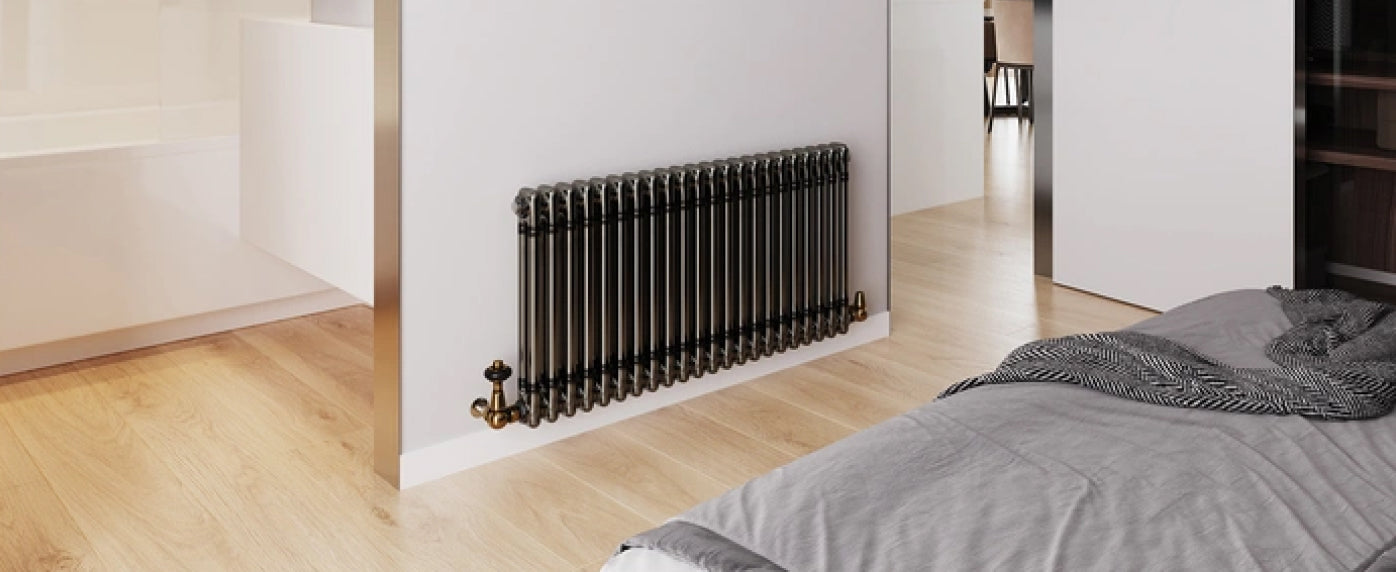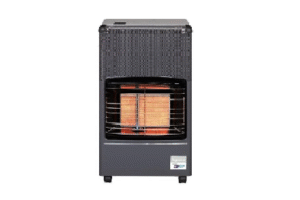
There is an intangible quality to a truly great room. It’s a feeling that goes beyond the visual. You can have the perfect colour palette, the most enviable furniture, and flawless lighting, but if the space feels wrong, the entire design fails. This “feeling” is often a subconscious response to the room’s unseen atmosphere: its air quality, its acoustics, and most importantly, the quality of its warmth. We’ve all experienced the opposite: a room that is technically “warm” but feels stuffy, dry, and vaguely unsettling, with cold spots by the windows and a parched, static quality to the air. For decades, we accepted this as the simple, unavoidable price of not being cold.
The problem is that we have been fundamentally mistaking “temperature” for “comfort.” We’ve been heating our homes using a brute-force method that focuses on one thing: raising the temperature of the air. This is the work of convection. But comfort is a far more delicate science, one that relies on a much gentler, more pervasive force: radiation. The most significant shift in modern interior design isn’t just about how our heating looks; it’s about a return to engineering how it feels. The new generation of architectural heating is a deliberate, intelligent move away from heating the air and a return to the profound, superior comfort of heating the people within it.
The Convection Conundrum and the Failure of the “Hot Box”
To understand where we’re going, we must first appreciate the problem we’re leaving behind. The standard-issue heating appliance, the ubiquitous white panel, is essentially a “hot box” designed for one purpose: convection. Its design is simple: hot water flows through a panel, which is shielded by a secondary panel and often a set of “convector fins” inside. This design is intended to draw in cold air from the floor, heat it rapidly, and expel it from the top. This creates a constant, rolling current of air in the room. The hot air rises to the ceiling, pushes the cold air down, and the cycle repeats. You are not sitting in a warm room; you are sitting in a “thermal loop,” a machine for processing air.
This convection-first model is the source of that familiar stuffy, dry-air feeling in winter. It’s a brute-force method that churns the air, circulating dust and allergens, and creating an uneven “thermal gradient” where the ceiling is warm and your feet are cold. This is why the aesthetic and functional evolution toward designs like column radiators is so significant. Their very structure, with multiple tubes creating a vast, open surface area, is a direct challenge to the “hot box” model. They are built to do more than just process air; they are designed to radiate warmth directly into the living space, offering a more balanced, comfortable, and efficient profile that engages with the room, rather than just circulating its air. This old model is fundamentally inefficient. To make a person sitting on a sofa feel warm, this system must heat the entire volume of air in the room, from the floor to the ceiling, which takes an enormous amount of energy and time. It’s a solution that is both physically uncomfortable and economically wasteful.
Re-discovering Radiation: The Physics of True Comfort
The alternative is not new; in fact, it’s the oldest form of heat there is. It’s radiant heat. This is the warmth you feel from a ray of sunshine, the glowing embers of a fire, or even the proximity of another person. Unlike convection, which wastes its energy heating the intermediary air, radiant heat travels in invisible waves and warms objects directly. It warms your skin, the sofa you’re sitting on, the floorboards, and the walls. These objects then store that warmth and gently release it, creating a stable, enveloping sense of comfort.
This is a superior-feeling warmth for a crucial scientific reason, one that experts call “Mean Radiant Temperature” (MRT). Our perception of comfort is not just about the air temperature. It’s a 50/50 split between the air temperature and the average temperature of all the surfaces surrounding us. This is why you can feel “cold” in a room with a 22°C thermostat reading. If you are sitting near a cold, poorly insulated wall or a large, single-glazed window, your body is constantly radiating its own heat out to those cold surfaces, making you shiver. The convection-based heater is fighting a losing battle, trying to replace that lost body heat by super-heating the air, which only makes it drier and stuffier. The radiant-based solution is far more elegant. Instead of just heating the air, it warms the cold wall, raising the room’s overall Mean Radiant Temperature. When the surfaces around you are warm, your body stops losing its own heat. You feel comfortable, stable, and secure at a much lower, fresher air temperature. This is the secret to a room that feels as good as it looks.

The “Surface Area” Solution: How Form Dictates Feeling
So, if the goal is to maximise radiant heat, how do we engineer a radiator to do that? The answer is simple: surface area. A radiator can only radiate heat from the surfaces that can “see” the room. A single flat panel has a very limited, one-dimensional surface. To get a high heat output, it must become intensely hot, which in turn leads to more aggressive convection as the air that touches it is scorched and rises quickly. It’s a design that fights against the goal of gentle, radiant comfort. This is where the brilliant engineering of the column-style radiator comes into play. Its form is not just an aesthetic choice; it is a functional masterpiece.
Let’s consider the geometry. A traditional column radiator is composed of multiple vertical tubes, often arranged in banks of two, three, or four columns deep. Each individual tube has a 360-degree surface. When combined, these tubes create a total surface area that is exponentially larger than a flat panel occupying the same wall footprint. A 10-section, 3-column radiator, for example, has the radiating surface of 30 individual tubes, not one flat plane. This vast surface area is the key. Because the surface is so large, it can release the same amount of heat (or more) as a panel, but at a much lower, gentler surface temperature. This lower temperature is the “golden ticket” to comfort. It dramatically reduces the harsh convective currents and instead allows the radiator to push out a huge volume of soft, radiant warmth. This warmth bathes the room and its occupants, raising the Mean Radiant Temperature and creating that elusive feeling of deep, quiet comfort. This is also why material choice matters. Cast iron, with its heavy, dense mass, is the king of this process. It acts as a “thermal battery,” storing heat and radiating it slowly and consistently for hours. Modern steel provides an excellent compromise, heating up faster while still being easily formed into the high-surface-area columns needed for a strong radiant performance.
The New Dialogue: Integrating Heat into the Architectural Fabric
Understanding this principle—that the form is the engine of the feeling—completely changes the role of the radiator in the design process. It is no longer a “finishing touch” or a problem to be solved. It becomes a primary, active tool for engineering the comfort of the space. The designer is no longer just asking “Where can this fit?” but “How can this element modulate the feeling of this room?” This new dialogue is where function and aesthetics finally become one. The placement of a radiator is no longer dictated by old habits, but by modern, functional strategy. That cold, north-facing wall that has always made the living room feel unwelcoming? A standard convector would just be churning hot air nearby. But a tall, vertical radiator, placed directly on that wall, becomes a thermal shield. It constantly bathes that cold mass in radiant heat, neutralising the cold spot at its source and fundamentally changing the room’s comfort profile.
In a large, open-plan space, this new approach is even more liberating. The old method would demand heating the entire, cavernous volume of air to a single, high temperature—a hugely inefficient and expensive task. The new, radiant-focused method allows for “comfort zoning.” You can place a powerful, high-surface-area radiator next to the main seating area. This creates an “island of comfort,” where the people in that zone are warmed directly by radiant heat, feeling perfectly comfortable even if the air temperature in the unused corners of the room is several degrees cooler. This is an intelligent, intuitive, and efficient way to live. This is why the visual options—the finishes like raw metal, anthracite, or classic white—are so important. They allow this functional engine to become part of the home’s material palette. A raw metal lacquer finish doesn’t just “look industrial”; it creates a visual link to other hard finishes like exposed brick or concrete floors, making the radiator feel like a natural, intentional, and integrated part of the architectural fabric, not an appliance that was added on later.
Conclusion: The Sincerity of a Well-Tempered Home
For too long, we have been forced to choose between style and comfort, or worse, we have accepted a poor version of both. We have hidden our heating, ignored its function, and endured its uncomfortable, inefficient output. That era is definitively over. The new generation of heating design is a quiet revolution, a move away from the brute-force heating of air to the intelligent, gentle warming of people. We have rediscovered the simple, profound physics of radiant heat and, in doing so, have unlocked a new, higher standard of living.
The shape of the modern radiator is the physical manifestation of this new understanding. Its form—the multiple columns, the tall vertical profiles, the vast surface area—is not a stylistic whim. It is the very engine of this superior comfort, the tool that allows us to move from harsh convection to enveloping radiation. When you choose a radiator, you are no longer just buying an appliance. You are making one of the most fundamental decisions about how your home will feel. You are choosing to engineer your own comfort, to create a space that doesn’t just look warm but is warm, in the truest, most complete sense of the word. This is the ultimate goal of all good design: a home that feels as beautiful as it looks, where the comfort is not an accident, but a deliberate, integral part of the architecture itself.



